“Roll” Laminating
Laminating via a roll — instead of a series of folds — is a very old technique. It likely predates folding lamination by several centuries. Introduced to Europe by the Arabs sometime around the high Middle Ages, it found favor in the more fashionable courts of Spain and Italy during the Renaissance. Over time it’s mostly faded from view, though it still hangs on in a few odd corners of the culinary world. I think it’s ready for a comeback.
Lamination by roll, just like lamination by folding, takes practice to truly master. I certainly haven’t mastered it, but now that I’ve more or less nailed down a formula and a process I think I’ll be doing it a lot more. I formulated and mixed the dough in such as way as to maximize gluten development. What results is an unusually soft yet elastic dough that can stretch even beyond what’s necessary for most roll-laminated projects. But that extra pliability makes it a lot more forgiving than other formulas I tried, and that’s always a nice feature.
Try this and I think you’ll quickly see the advantages of this method over pasta machines and store bought filo. Not only is this a lot closer to the original Arab technique (and that’s fun from a historical perspective) there’s a lot less fuss and fiddling with machinery. It’s both faster and cheaper than using store bought dough, and delivers a better end product. What’s not to love? To make this dough you’ll need:
16 ounces (3 cups) all-purpose flour
3/4 teaspoon salt
9 ounces (1 cup 2 tablespoons) lukewarm water
3 ounces lard or butter, or a combination of both, soft
about another six ounces of butter and/or lard for spreading on the dough sheet
Combine 14 ounces of the flour — not all of it in other words — and the salt in the bowl of a mixer fitted with the paddle. Add the water and stir until everything is moistened.
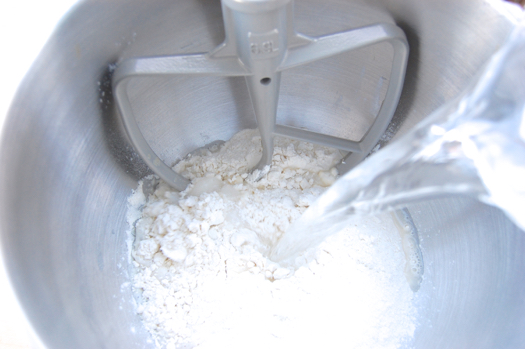
Switch to the dough hook and knead for five minutes…
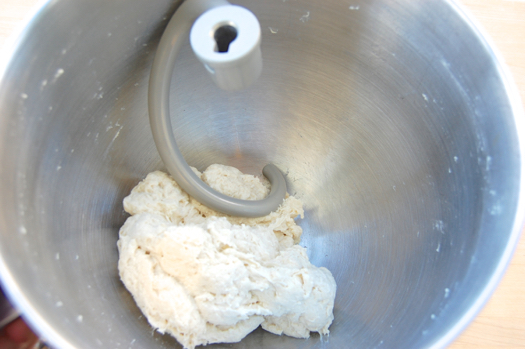
…until the dough is smooth. At that point knead in the fat ounce by ounce until it’s all incorporated.
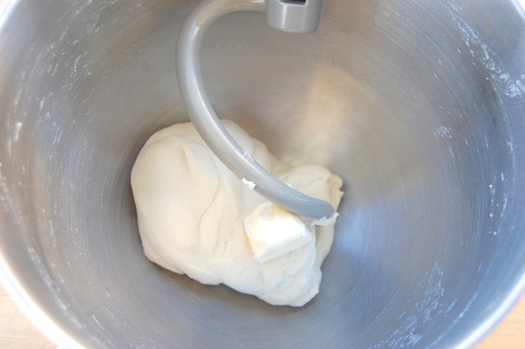
A spiral dough hook is really a poor tool for this. If you find that your dough hook is just smearing the dough around on a slippery film of fat, switch back to the paddle for about three minutes until the fat is incorporated and the dough is more or less smooth again.

At that point switch back to the hook and knead in the last of the flour. Why do it this way? Because if I put all 16 ounces of flour in at the beginning the dough would be too stiff to take up the fat easily. Adding it in stages makes the whole process easier.
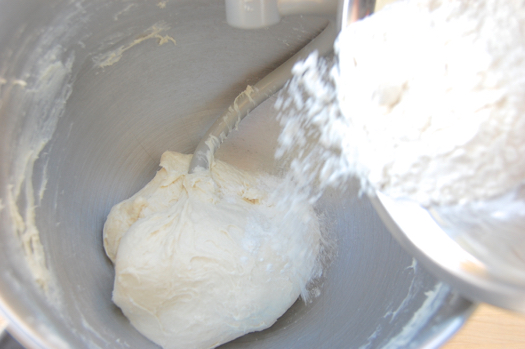
After about two more minutes you’ll be done. Let that rest at room temperature for an hour. It can really rest all day if you feel like waiting.

When you’re ready to roll, lay a sheet out on a dining room or card table that’s at least 36″ x 36″. Sprinkle flour all around and rub it into the fabric. Yeah you’ll probably get butter on it. Make sure it’s an old sheet. Also, set the 6 ounces of butter and/or lard in a small pan on the stovetop, get it melting on the lowest possible heat. By the time the dough is stretched it’ll be ready.
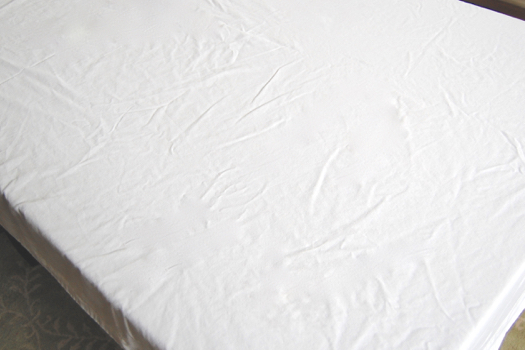
Plop down the dough in the center, flour it, then get out your biggest pin and roll.
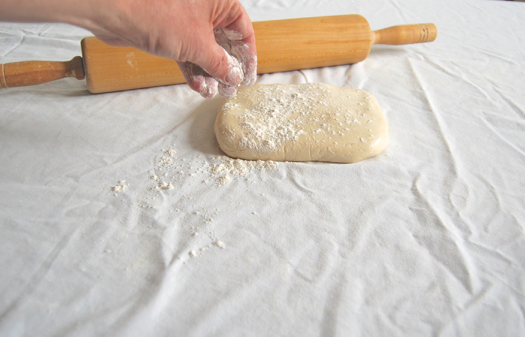
The shape isn’t terribly important, just get it to about 18″ x 18″ before you start stretching it. You’ll find this easy, I promise. In fact if you want to make a double batch of dough, just so you have one batch to play with and destroy first, I highly recommend it. There’s nothing like wrecking something to give you confidence…and this dough is cheap to make.
Reach your hand under, extend your fingers, and pull steadily and slowly from the center. Note that by going very, very slow you get a nice, even stretch. Do this two or three times just because it’s cool.
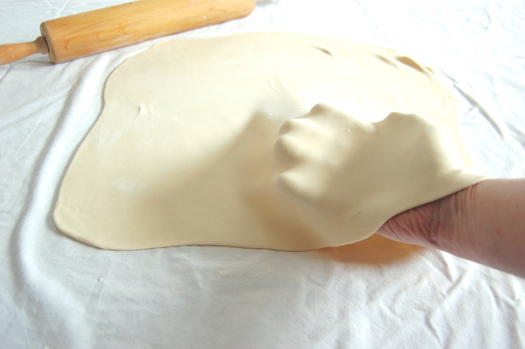
Pull from the flat sides…
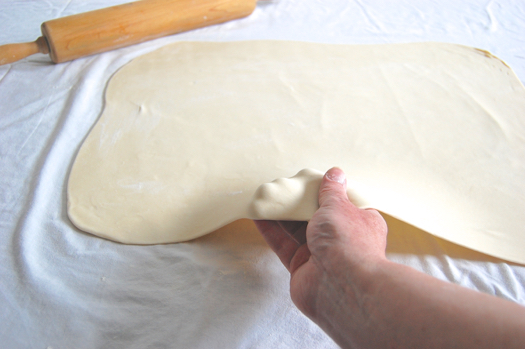
…pull from the corners. As you pull you’ll notice the sheet getting bigger. You’ll also notices variations in color between the very thin regions (whitish) and the thicker regions (grey/brownish) which will give you clues about where to stretch next.
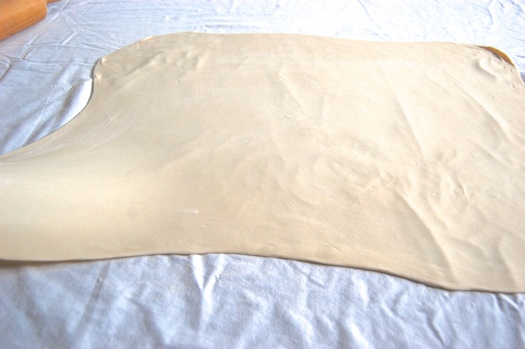
You want your finished sheet to be 36″ long by 32″ wide — or so.
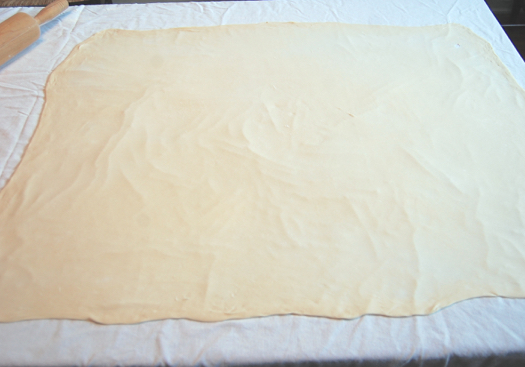
When you’re more or less there, trim off an inch from all sides…which will be thick and doughy…we don’t want those. Don’t press too hard or you’ll put scratches on your dining room table and your wife (or husband) will kill you.
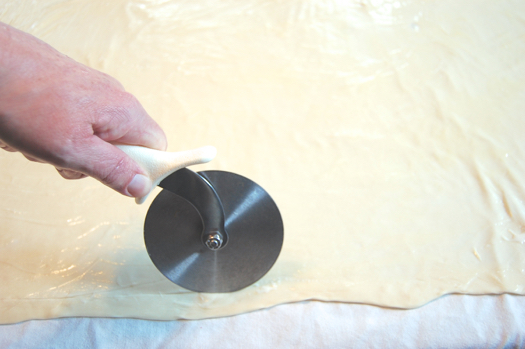
Now for the fun part: the fat. Pour it on about an ounce at a time, being methodical in the way you apply it: first a corner, the a side, then a far corner. The reason is because you want to get a fairly even coat on. If you pour it all in the middle at once and start to smoosh it around you’ll get an extra-thick layer in the center as the fat starts to firm — and the fat will firm unless you’re making this in an 85-degree kitchen. Get it right out to the very edges. You want a good smear of fat on everything, get me? You may not use all 6 ounces, but you’ll want to use at least 5.
Lard is traditional for this sort of laminating, but butter works every bit as well. Combine the two if you want to split the difference. I did and loved it.
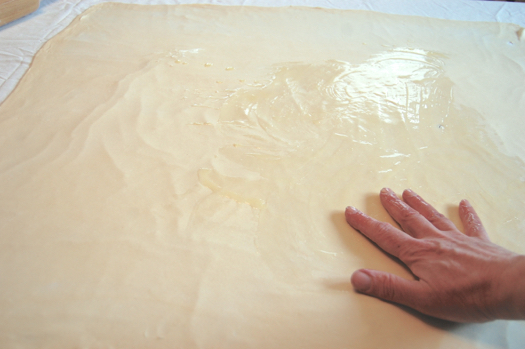
Now for the rolling. If you’ve watched YouTube videos of burly Italian guys stretching their sfogliatelle dough while they roll AND smear fat all at the same time…don’t do it that way. That works for an industrial quantity of dough. For a small quantity like you and I will use at home, you don’t want to stretch — at all — after the fat is applied, as that will mess up your layers later. You just want to roll.
So…looking down the dough sheet from the narrow side — the (now) 30″ wide side — make little hash marks every six inches. Then using a long ruler and a pizza cutter, cut the dough into five equal strips. Again, look out not to press too hard lest you have to explain later that you made the mistake of listening to Joe Pastry one day and the result was a ruined table top.
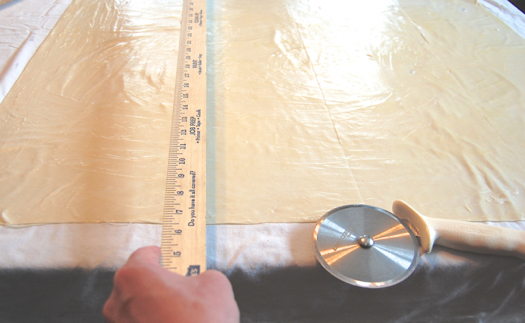
Starting with the first strip, start rolling. It doesn’t have to be crazy tight, so don’t go nuts here. Just…roll.
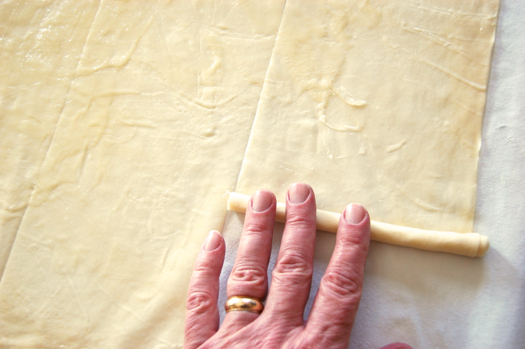
When you finish with one strip, just pick up the roll and place it at the end of the next one. Don’t try any fancy joinery here, this is pastry, not master woodworking. Just plop it down and roll, damn you, ROLL!
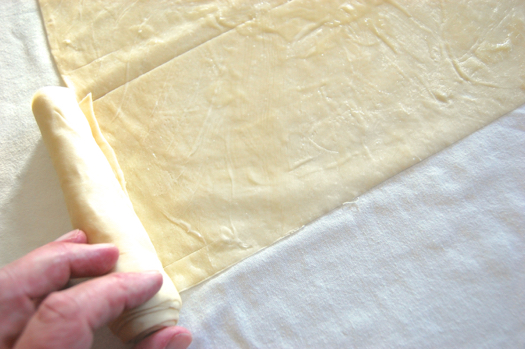
The roll will keep getting fatter, obviously. Don’t stress if the very ends aren’t perfect, that’s normal.
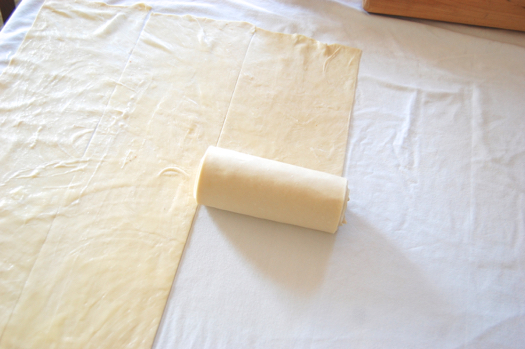
When the dough is all rolled up your log should be 3″ thick, which is just about perfect for sfogliatelle or whatever else you want to make.
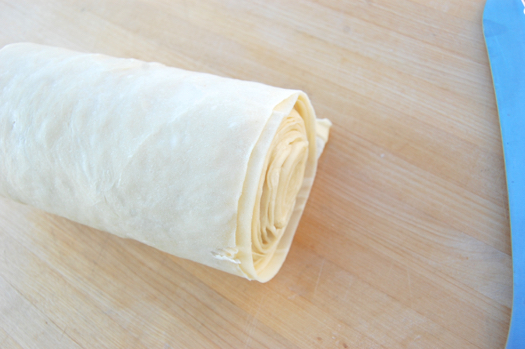
So what if you decide you want the layers thinner? Easy, just stretch your sheet out to 38″ instead of 32″. Trimmed, you’ll be able to cut six 6″ strips. For thicker layers, do the reverse. But this dough can get ridiculously thin, just pull slowly and steadily. I got it this thin with very little effort and not a single rip.
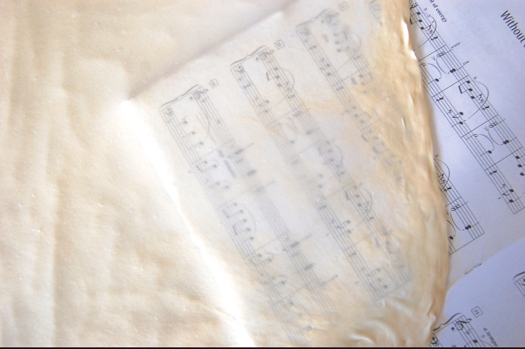
I may substitute this for my brik pastry and strudel dough!
So you are using a liquid (melted) fat, correct? I asked about the ghee possibility after watching one of those burly Italian baker teams splosh liquid fat all over their rolled dough. So, why do melted whole butter and butter/lard mixtures work, but butter sans solids do not? Nicely stretched, by the way – I don’t see even one tear along the edges. Pretty impressive that is, in my book!
Hey Jeannine!
It’s possible we’re both thinking about ghee differently. The ghee I know is partially liquid even when it’s completely cooled, and I think that would be too thin even for this application, which depends on the fat firming back up at least a little bit once it’s in the roll (or in this case on the sheet). I could be completely wrong about that. There’s only one way to know: try it! And get back to me with the results, please! 😉
Cheers,
– Joe
I also meant to say: thanks! However this dough is so extensible I can scarcely take credit for that. It can be stretched much thinner than this…so thin that it ceases to become a dough “sheet” and might more accurately be called a dough “film”. I may well substitute this for recipes that call for brik pastry in the future. It makes that stuff look thick by comparison!
– Joe
OK, I’m confused. For folded pastry it was drilled into my head that the fat had to be cold, cold cold! Roll & fold twice (once if the kitchen is really warm) then refrigerate to get the fat cold again. I was told that if the fat started to melt it would ‘soak’ into the pastry & you’d get no layers. What magic be this?
Arrrgh, what sorcery be here before me? 😉
Good point, Frankly. “Soak in” isn’t a totally precise term. If butter soaked into sheets of dough that readily or quickly, filo wouldn’t work. But there’s another problem with butter when it goes completely liquid: the emulsion gets all messed up. That’s a problem because the water in the butter pools up and/or evaporates, and it’s the water that conventional (folded) laminated dough relies on for its upward push. Without it you get no steam, in other words. So melted butter in that case is a problem. Here it isn’t because instead of pushing the layers apart with steam we’ll be separating them manually (or with the aid of another expanding agent like choux paste…in the case of lobster tails). So even steam is not, strictly speaking, required.
Does that make sense?
– Joe
Partially makes sense. I knew about the water being the key in folded but still don’t know how you are getting layers from this. Maybe I’ll just wait until you show the whole thing & then it’ll make sense.
BTW – I have a bad habit of talking in shorthand so things like ‘soaked in’ are me being lazy. It works when everyone is on the same wavelength but not so much when trying to be precise. Thanks
Hehe…I have the same issue, Frankly!
– Joe
It’s up now, Frankly…done by my Italian alter-ego!
– Joe
I’ve always done it with a pasta machine to get the dough super thin. I roll it to the thinnest setting then stretch it a bit as I roll. It’s not something I do very often and I never seem to get enough filling in!
Hey Sarah!
Far be it from me to push you away from a technique that works for you. If you have a method you like by all means stick with it. What I will say is that this dough can get amazingly thin. Tomorrow I’ll put up a picture at the end of the post to give you a sense for it.
Cheers,
– Joe
Could you take the laminated roll and then roll it into a flat rectangle and then use it as you would puff pastry dough?
That’s the tough part about this sort of laminating, Tom. It doesn’t really lend itself to many shapes other than a circle or folded circle…which I assume is a big part of the reason pastry makers moved to folded dough. Great question!
– Joe
Question: after re-rolling the piece of the log into a sfogliatelle or whatever, is there any benefit or hazard to putting an egg wash to enhance the golden-brownness of the final product? I can talk myself into both answers so I look forward to your more educated wisdom.
Hey Brian!
I tried both in my many attempts. Actually in the second try (“Getting Better”) the two all the way to the right were painted with egg wash. It did almost nothing to brown them and actually did cause the layers to stick together just a bit more. To me there seems to be no real point. But try it if you like. It won’t cause any disasters.
Cheers,
– Joe
p.s. Follow-up question: do you get professional manicures? Your nails always look so nice. 🙂
Oh, you silver-tongued devil, you. I have no “moons” on my fingernails which might give the impression I use nail polish. I don’t, nor do I get manicures, but I do have good hand genes. My mother — believe it or not — was a hand model once upon a time. Her hands were on the packaging of Sara Lee coffee cakes. Who knew that legacy would be useful for me one day? Baking, writing, hand modeling…it seems my entire life and history has been building to my food blogging career.
Which is so depressing I think I’m going to cry. God, what did I ever do to you?
– Joe
I just wanted you to know how much I enjoy your site. I am so glad that I found you; I learn so much whether it be technique or history about baking. I certainly didn’t consider myself a baking slouch and now I feel like I can do so many techniques I had never heard of before! Thank you Joe.
What a wonderful comment! Thank you very much, Anna. It’s a very great pleasure to do this, especially when I get this kind of generous praise!
Your friend,
– Joe
An old edition of the Joy of Cooking describes this method applied to strudel dough. It’s always fascinated (and daunted) me. You make it look easy!
Very interesting. Actually I used strudel dough as my starting point for this formula, but made it even stutter with the mixing and fat. I guess I can’t honestly say this is an “easy” project, but with a little practice and fiddling around it can certainly become so. I hope you’ll try it and get back to me with the results!
Cheers,
– Joe
Hi Joe,
My goodness, I’ve never even heard of sfogliatelle but these pastries look beautiful! And you make it look so easy. One thing, though. Are my eyes getting fuzzier or do I see a cup measurement of 1/2 cup for nine ounces water? I would have thought that nine ounces would be just over one cup. By the way, I second the “hand model” comment. Second career option maybe?
Hey Bina!
You’re completely right — thank you. I changed the formula so many times I forgot to correct the volume measure for the water. You’re a peach! As for the hand modeling, maybe I’ll turn into George Costanza and start wearing gloves with lotion on the inside. Watch the hands! Watch the hands!
Cheers,
– Joe
I love Seinfeld; everything in life can be related to a Seinfled episode. As to the dough, can I roll it and then freeze it for later?
You sure can, Anna! Make sure you wrap it nice and tight and you can keep it for several months in the freezer. Being it completely back to room temperature before shaping.
– Joe
Joe, did you see the recipe for “Peanut Sugar Morning Buns” over at Lady and Pups? She “speed folds” dough by rolling it; take a look.
http://ladyandpups.com/2014/03/12/speed-folding-peanut-sugar-morning-buns-eng/
Hey Ted!
That’s the “quick” method for making Danish dough (she just happened to roll it up). It’s not as flaky as the regular stuff, but to works!
– Joe